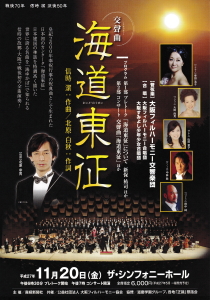Composer Kiyoshi Nobutoki’s Kaido Tosei Performed for First Time in 75 Years at the Symphony Hall
The Symphony Hall in Osaka City Kita Ward held performances of the 1940 cantata Kaido Tosei by the Osaka-born composer and former Tokyo University of the Arts professor Kiyoshi Nobutoki and poet Hakushu Kitahara on November 20 and 22. The complete work was performed for the event Keido Tosei Cantata—70th Anniversary of the End of World War II and the 50th Anniversary of the Death of Kiyoshi Nobutoki, sponsored by the Sankei Shimbun newspaper in cooperation with the Symphony Hall with the support of the Jikei Group of Colleges. All 1700 seats in the hall were sold out for the performances.
Kaido Tosei was composed in 1940 to celebrate 2600 years since the start of the Imperial Era beginning with the accession of Emperor Jimmu and was first performed on November 26 of the same year at the Hibiya Kokaido in Tokyo. It was performed in Osaka 3 days later. The piece was actively performed throughout Japan during the war, and a concert was also held in Osaka in December of 1944, conducted by the late Takashi Asahina, founder of the Osaka Philharmonic Orchestra.
Performances of the cantata mostly came to an end after the war, as if the composition had been sealed away. This year marks 70 years since the end of the war and 50 years since Kiyoshi Nobutoki’s death, and the Sankei Shimbun newspaper decided to sponsor a concert in Osaka, the city of Nobutoki’s birth, in order to mark the occasion.
Kiyoshi Nobuyoki composed school songs for more than 1000 universities and high schools across the country, including one for Keio University. This year also marks the 50th anniversary of the death of Kosaku Yamada, who was a year older than Nobutoki and studied at the same school, the Tokyo School of Music (now the Tokyo University of the Arts). However, whereas Yamada remained in the limelight following the end of the war, Nobutoki largely disappeared from the public eye.
We are told, however, that Nobutoki became friends with many artists and intellectuals who worked out of Osaka, such as the author Takeo Fujisawa, painter Narashige Koide, who together with Nobutoki attended Ichioka Junior High School from the previous education system (currently Osaka Prefectural Ichioka High School) and author Tsuneo Ishihama’s father, Juntaro Ishihama, historian of oriental history, among others and helped to support the advancement of culture and fine arts from behind the scenes after the war as well.
The Jikei Group of Colleges and the Symphony Hall collaborated out of a desire to contribute to the advancement of the culture and fine arts of Osaka, driven by the enthusiasm of the Sankei Shimbun newspaper to shine the light once again on a great Japanese artist, born in Osaka, and forgotten after the war. This Nobutoki composition was performed 71 years previously by the Osaka Philharmonic Orchestra under the baton of Takashi Asahina, who had a deep connection with the Symphony Hall, managed by the Chairperson of the Jikei Group of Colleges, Kunihiko Ukifune.
Before each of the two performances, literary critic and Tsuru University professor Yuji Shinpo gave a pre-performance talk in which he introduced Kaido Tosei, the cantata which brought together Nobutoki Takashi and Hakushu Kitahara and incorporated melodies of Japan from sources such as Japanese court music and folk songs into Western music, along with the wonder of the poetry written in the language of ancient Japan. He told the audience that listening to the performance at the Symphony Hall was a historically significant moment and further commented that “The the revival of Kaido Tosei is a symbol of Japanese people breaking free from defeated Japan’s psychological curse.
Following a performance of an arrangement of Beethoven’s Symphony No. 5 incorporating a Japanese melody by Hidemaro Konoe in the first half of the program, Musashino Academia Musicae professor Yukio Kitahara, who studied under Seiji Ozawa and Leonard Bernstein, led the Osaka Philharmonic Orchestra and Choir, Osaka Sumiyoshi Boys & Girls Chorus, and 5 soloists including Hiroko Koda, one of Japan’s leading sopranos, and tenor and Senzoku Gakuen College of Music professor Satoshi Chubachi in a passionate performance of the Keido Tosei Cantata.
The story of the birth of Japan—at times furious while at other times gentle and graceful—was performed through the poetry of Hakushu Kitahara, which resonates with the Spirit of Japan, and the breathtaking music of Nobutoki. The First Movement, Takachiho, opens with a light melody, played by the flute, evocative of solemn Japanese court music, and continues on to the Second Movement, Yamato Shibo, and then through to the Eight Movement, Tengyokaiko.
The majestic music of the Osaka Philharmonic Orchestra blended together with the noble and dignified Japanese poetry sung by the chorus in the hall. For the encore, the orchestra and choir performed Ukiyukaba, and the audience, who filled the hall up to the 3rd level seats, stood up one by one with their handkerchiefs in their hands for the emotion-filled choral finale.

